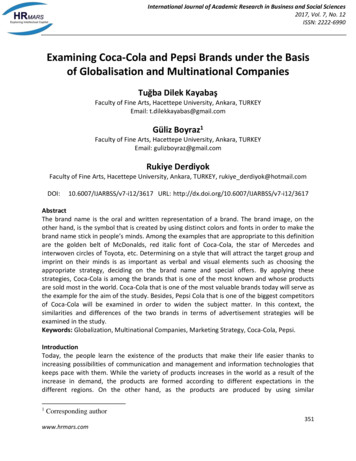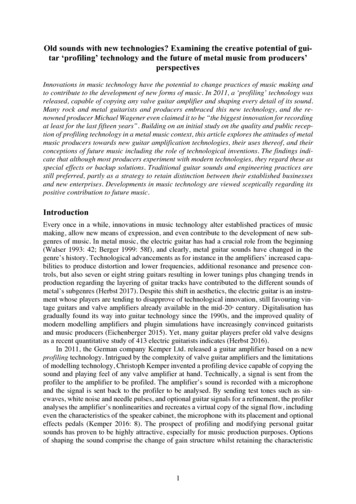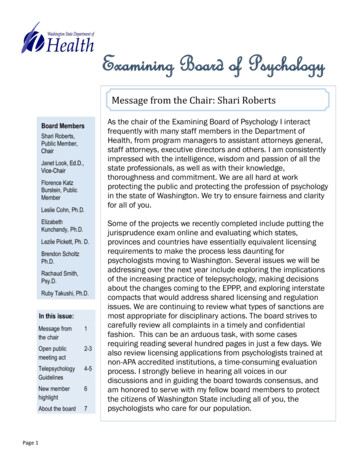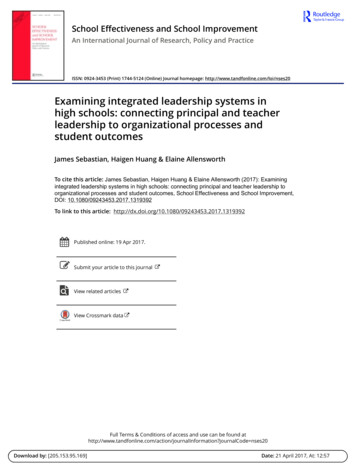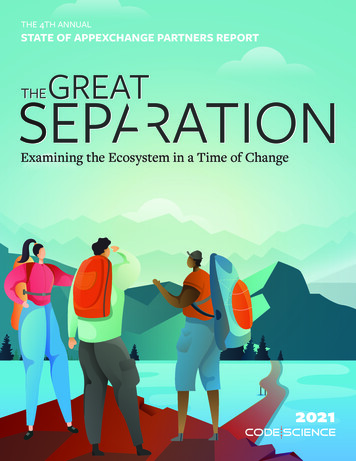
Transcription
TNEMYOLPEMEDUCATIONWorking TogetherExamining Employment, Education, andTraining Strategies for the Jamesville,Beasley, and Keith NeighbourhoodsA report of the Labour Market Action Partnership
Submitted May 2014 by Jeff Wingard, Structure ConsultingWith contributions from Sarah Hosick, Workforce Planning Hamilton
Working TogetherAcknowledgmentsA sincere thank you to the members of the Labour Market Action Partnership Steering Committee, who are listed in Appendix A of this report, for their guidance, vision, and knowledgethroughout the development of the project. In particular, Judy Travis, Sarah Hosick, and the teamfrom Workforce Planning Hamilton, Jim Vanderveken, Samara Young, Muzeria Nuredini, and SueMacKay from Mohawk College, and Suzanne Brown from the City of Hamilton NeighbourhoodOffice provided strategic advice, operational support and supervision, and a dedication to helpstrengthen and build neighbourhoods that brought about a much stronger result.The community leaders and educators who gave of their time to be interviewed as key informantswere vitally important, as were those who helped set up focus groups with students or adultswho access their services. Thank you for sharing your expert knowledge and experience aroundeducation and training issues.This project also required input from over 50 employers from lower Hamilton, and thanks aredue to them for taking the time to tell us about the challenges they face in terms of recruitingand retaining workers.One of the most compelling aspects of this research was talking with over 60 neighbourhoodresidents of Keith, Jamesville, and Beasley about their experiences with education, their hopes forbetter jobs, and their suggestions about how to achieve those better jobs. Without their braveryand courage to share those experiences and ideas, this research would not have been possible.The Neighbourhood Planning Teams in Keith, Jamesville, and Beasley deserve substantial creditfor identifying employment and training as an issue that will make neighbourhoods stronger,as well as giving feedback and guidance along the way to make sure the findings were actionoriented and grounded in the community.Finally, we would like to thank Employment Ontario for the funding that made this work possible.
Table of ContentsExecutive Summary. 11. Introduction. 52. Labour Market Profile: Jamesville, Beasley,and Keith neighbourhoods.73. Best Practices High School.123.1 Post-Secondary. 163.2 Skills Training. 194. Review of Learning Annex Models.225. Results – Key Informants.285.1 Barriers, Solutions, and Solutions. 295.2 Exploring the Concept of a Learning Annex. 346. Results – Neighbourhood Residents. 376.1 Barriers, Solutions, and Solutions. 386.2 Exploring the Concept of Learning Annex. 437. Results – Employers.468. Analysis and Recommendations.519. Conclusions.58References.59Appendices.61
Working TogetherExecutive SummaryThis research project began with the Neighbourhood Planning Teams in the Hamilton neighbourhoods of Jamesville, Beasley, and Keith identifying challenges in employment, education,and job-skill training among their residents. The increasing skill requirements of employers inlocal economies across Ontario have been noted by many organizations like Essential SkillsOntario, who said “low skilled jobs are becoming mid-skilled jobs, they all require technology”.In addition, in Hamilton alone, retirements are expected to create over 20,000 job openings inscience, engineering, technology, business and finance – with most of these jobs requiring atleast a two-year college diploma.In partnership with the Neighbourhood Planning Teams, a project team made up of educators,community organizations, community developers, funders and led by Mohawk College, WorkforcePlanning Hamilton, the City of Hamilton’s Neighbourhood Action Strategy with funding fromthe Ministry of Training, Colleges and Universities initiated this six-month research project withthe following goal:To work with neighbourhoods (residents, planning teams, organizations, and employers) todevelop and implement strategies to improve high school completion rates, participationin post-secondary education and employment training that will lead to higher rates oflabour force participation and better jobs for neighbourhood residents.To achieve this goal, there were three sub-projects:1. To identify the barriers, challenges, and solutions to employment, education, and training;2. To engage Hamilton employers to better understand their experience and skill requirements;3. To explore the concept of a neighbourhood-based Learning Annex as a tool to achievethe above stated goal.Over the course of the research, an analysis of Labour Market conditions was completed foreach neighbourhood. Best practice reviews were completed for high school completion, postsecondary attendance, and skills training programs. A review of Learning Annexes and LearningCentres were reviewed to provide examples of possible modes of delivery. Finally, informationfrom over 65 neighbourhood residents, 55 employers, and 26 key informants was gathered.Labour Market AnalysisA detailed labour market analysis of each of the three neighbourhoods was completed. Thisassisted in focusing our research questions. Among other things it revealed: Declining population growth ranging from -1% in Beasley to -10% in Keith Jamesville and Beasley neighbourhoods have much higher rates of immigrants and visibleminorities than the city of Hamilton average, while Keith has below the city average forboth groups Residents in these neighbourhoods have lower educational attainment than the city ofHamilton average, but younger cohorts are more likely to finish high school and attendcollege and university1
All three neighbourhoods have lower labour force participation rates, lower employment,higher unemployment rates and higher rates of people on social assistance than Hamiltonas a whole.Best Practices ReviewA literature review and further research identified key findings and best practices related tohigh school completion, post-secondary attendance and skills training. A review of LearningAnnex models in other communities revealed a wide range in size, number of sites, budgets,and functions of Learning Annexes across Canada and the U.S. Models included those that werea physical, geographical location (a building), a mobile model, or a virtual model. Key to mostof these models is partnership.Key Informant Interviews: Key Findings2As noted above 26 key informants from the service provider or education community wereinterviewed to identify barriers and explore solutions including a Learning Annex model. The majorbarriers identified to high school completion were family experiences, mental health, negativeschool experiences, and language. Recommended solutions included the current student successstrategies and re-engagement work, strengthening and expanding mentorship and academicsupport programs, and building partnerships with community agencies. Educators and serviceproviders proposed the following functions for a Learning Annex: raising aspirations aroundeducation and skill training, finding creative ways to engage neighbourhoods around educationand training, engaging people where they already are (being mobile), building relationships withemployers, offering expertise and navigation assistance, and accessible, innovative programming.Sixty-five neighbourhood residents including youth were also contacted to identify theirperspective on education and employment. Key concerns related to high school non-completionincluded child care/teen pregnancy, major family events or breakdown, negative school experiences, substance abuse, and language. Regarding post-secondary education, barriers includedfinancial issues, needing more assistance and guidance, child care, more direct links to employmentand language. The majority of residents interviewed were interested in the Learning Annexmodel although youth and adults had a somewhat different perspective. Youth were looking foropportunities around athletics, mobile services (to where youth already are), someone to helpplan and navigate options, trips to campus, and financial incentives. Adults looked for trainingwith directs links to employment, information/support around how to get started with training,on-site child care, on-line or blended learning opportunities, financial incentives, an accessiblelocation, and specific training for foreign-trained professionals.Also consulted were 55 employers across all three neighbourhoods. Amongst employers surveyedthe employment outlook was generally positive. Most employers reported they have very littletrouble attracting entry-level applicants generally, but do have more trouble with specializedpositions, including the skilled trades. A majority of employers advised that the best way forneighbourhood residents to get hired in their workplace is to “go back to school and get therequired diploma or degree”. Employers were generally interested in the Learning Annex modelbut unsure of how to be involved.
Overall, the Steering Committee and Neighbourhood Planning Teams felt this research found verystrong support and evidence for further development of training, skill building, and educationalresources in the Keith, Jamesville, and Beasley neighbourhoods. The suggested priorities were:1) increased resources and support around navigation of education and training pathways, 2)increased activities to raise aspirations and create engagement around training and education,3) engaging employers in the overall process, 4) and reducing barriers and creating incentivesto training and education programs.Given the findings of the research, the report made the following recommendations:Recommendation 1The Steering Committee and neighbourhood hubs should pursue resources for a Project Manager to coordinate the implementation and operationalization of a Learning Annex team.Recommendation 2The Jamesville, Keith, and Beasley Neighbourhood Planning Teams should create an Educationand Training sub-committee who will work with the Project Manager to develop and guide thisinitiative into Phase 2.Recommendation 3Identify resources to create an Education and Training Navigator position by the conclusion ofPhase 2 who will coordinate the activities of the Learning Annex Team to implement and overseeprogress on these recommendations.Recommendation 4Create an interdisciplinary Learning Annex Team through re-alignment of existing resources.Team members should include (at a minimum): City of Hamilton Neighbourhood Action Strategy,Ontario Works, Ontario Disability Support Program, Employment Ontario providers, SettlementWorkers, Community Development workers, School Boards, Mohawk College, and McMasterUniversity. This team needs to be able to provide services in different locations across the City.Phase II implementation plans include developing community protocols and partnerships;engaging neighbourhood residents; strengthening employer relationships and creating strategiesdesigned to raise aspirations around pursuing education and training. Work would be done inconcert with the Education and Training sub-committees of neighbourhood planning teamsand partnering organizations.Recommendation 5Explore the creation of an Opportunity Fund that would help make training or education financiallymanageable, particularly where existing programming does not provide enough assistance. Thisfund should be fast-tracked, and could be coupled with financial planning assistance.Recommendation 6Develop a child-care strategy that should include conversations with the Early ChildhoodEducation program at Mohawk, the Ontario Early Years Centres, and also the Best Start Network.3
Recommendation 7Develop an Equity Strategy that will guide the implementation of a Learning Annex.Recommendation 8Ensure that the Learning Annex Team has expertise in settlement issues, and can offer serviceto people who do not speak English as a first language.Recommendation 9Assess the need for specialized training for the Learning Annex Team around supporting peoplewith mental health issues and experiences of trauma.Recommendation 10The initial development of the Learning Annex should focus on the mobile component of servicedelivery. As the Learning Annex gains momentum and experience, additional strategies of programdelivery should be explored: including “bricks and mortar” space and virtual/web-based programs.Recommendation 11Develop a strategy for the expansion of after-school programs like Pathways to Education orRogers Raising the Grade to all students in Jamesville and Beasley neighbourhoods.4Recommendation 12Work with school boards and post-secondary institutions to improve the data collection anddissemination about neighbourhood level high-school completion and post-secondary attendance.
Introduction1The Jamesville, Keith, and Beasley neighbourhoods have come strongly together as leadersunder the City of Hamilton’s Neighbourhood Action Strategy. They have each completed detailedneighbourhood plans and have Planning Teams in place that are responsible for implementing theplans. These Planning Teams include a mix of residents, community organizations, and institutionsand have a demonstrated capacity for addressing challenging issues in their neighbourhoods.These diverse teams contribute countless volunteer hours to build safe and healthy communitiesand are grounded in the belief that everyone has assets that can be utilized and leveraged toimprove neighbourhoods across the city.Within these plans, increased high school completion, increased post-secondary education,access to apprenticeship programs and volunteer opportunities that will lead to job readinessand employment are recurring themes. In these neighbourhoods, poverty rates are much higherthan the city average, and unemployment rates tend to be double or triple the city average.Rates of high school completion and attendance of post-secondary institutions are well belowcity averages. More than 17% of Beasley students do not complete their high school diploma,Jamesville has more than double Hamilton’s proportion of students who do not complete highschool. Finally Keith has almost three times the amount of students who don’t complete highschool as compared to the general Hamilton population. Additional challenges in these neighbourhoods include higher rates of recipients of social assistance, and lower rates of educationalattainment by parents (which is a strong predictor of educational achievement by youth).Most factors that are creating these challenges lie outside the neighbourhood boundaries: locallabour markets across Hamilton, Ontario and Canada are shifting. According to the ConferenceBoard of Canada, anticipated skills shortages will require job searchers to have post-secondarycredentials to be competitive in the job market. Anticipated retirements in Hamilton by 2016 willprovide an estimated 21,000 job vacancies. Employers need post-secondary graduates in science,engineering, technology, business and finance. The most widespread needs are for employeeswith two or three year college diplomas (57%); four year degrees (44%), and trades (41%)1.Industries in Hamilton that contribute significantly to the labour force include Construction,Manufacturing, Transportation and Warehousing, Health Care and Social Assistance, BusinessFinance, and Administration. Due to anticipated retirements, current job vacancies, and newbusiness development, experts are predicting a shortage of skilled workers in these fields until20212.These broad changes in the labour market coupled with the development of the Neighbourhood Action Strategy present an opportunity for residents in the Jamesville, Beasley, and Keithneighbourhoods as well as their community organizations and partners. In partnership with theseNeighbourhood Planning Teams, a project team led by Mohawk College, Workforce PlanningHamilton, and the City of Hamilton’s Neighbourhood Action Strategy with funding from the12Conference Board of Canada 2013.Ministry of Economic Development, Trade and Employment 2013, and Manifold, Superdemographics, 2012.5
Ministry of Training, Colleges, and Universities initiated a six-month consultation process withthe following goal:To work with neighbourhoods (residents, planning teams, organizations, andemployers) to develop and implement strategies to improve high school completionrates, participation in post-secondary education and employment training that willlead to higher rates of labour force participation and better jobs for neighbourhoodresidents.3There were three associated sub-projects under this goal that directed the research and consultations:61. To work with neighbourhoods to identify the barriers to employment, training, continuing andfurther education, and to work with the neighbourhoods to develop strategies to overcomethese identified barriers.2. To engage a range of Hamilton employers (primarily specific to the neighbourhoods) to betterunderstand their requirements for skills training, what skills competitive job applicants needto possess, the challenges they are currently facing when considering candidates as well astheir recruitment techniques. This project will also build relationships between employers andthe neighbourhoods to develop informed labour market planning and skills development.3. The concept of a neighbourhood-based learning annex will be investigated as a tool toenable the stated project goal. This investigation will work with neighbourhoods, communityorganizations, and employers and may include the development of implementation plans,business cases and the required partnerships for a neighbourhood-based learning annexin Hamilton.To carry out this project, a Steering Committee was formed to oversee the project’s activities,provide guidance and support to the project strategist, advise on the analysis and recommendations, and monitor the project’s timelines and deliverables. Members of the Steering Committeeare noted in Appendix A.Over the course of this extensive research and consultation, an analysis of Labour Marketconditions was completed for each neighbourhood. Best practice reviews were completed forhigh school completion, post-secondary attendance, and skills training programs. A review ofLearning Annexes and Learning Centres were reviewed to provide examples of possible modesof delivery. Finally, information from over 65 neighbourhood residents, 55 employers, and 26key informants was gathered.Results from this research and consultations is presented in the sections that follow. The reportconcludes with an Analysis and Recommendations section that pulls together the findings fromeach of the different sections, and makes a set of recommendations to implement the strategiesin the Jamesville, Beasley, and Keith neighbourhoods.3Labour Market Action Planning, Project Charter, 2013.
Labour Market NeighbourhoodProfiles, Jamesville, Beasley, and KeithNeighbourhoods2This section of the report looks at the labour market factors in the Jamesville, Beasley and Keithneighbourhoods. Much of the information presented here is from the 2006 Census as data formost of these neighbourhoods from the 2011 National Household Survey has been suppressedfor data quality and/or confidentiality. Additionally, the authors would like to acknowledge theSocial Planning and Research Council’s work on Neighbourhood Profiles, as that report was aninvaluable resource in compiling this information4.In addition to census information, special data requests were made to determine the number ofpeople in each neighbourhood who were receiving employment insurance, Ontario DisabilitySupport Program or Ontario Works. This section then describes the most prevalent industriesand occupations for residents in the neighbourhoods as well as a brief description of studentperformance in the appropriate schools who draw students from Jamesville, Beasley, or Keith.In contrast to the City of Hamilton’s 6.1% growth, all three neighbourhoods experienced a declinein population since 2001, ranging from -1% in Beasley to -6% in Jamesville to almost -10% in Keith. The total number of people in these three neighbourhoods fell from 17,025 in 2001 to 16,246in 2011, a decline of 5% overall.In terms of the overall population of these three neighbourhoods, Jamesville represents 54%(8,705), Beasley 35% (5,854), and Keith 11% (1,687).Jamesville and Beasley neighbourhoods have much higher rates of immigrantsand visible minorities than the City of Hamilton average, while Keith has belowthe City average for both groups. Immigrants make up 44% of Beasley residents, 35% of Jamesville residents, and 14% of Keithresidents, compared to 25% of Hamilton.Overall, there are a total of 4,280 residents who identify as a visible minority or 26% of thepopulation compared to 14% of the City of Hamilton. The most common visible minoritiesare Black (1,165), Chinese (760), and Southeast Asian (575), and Latin American (495).The rate of lone parent families is higher in all three of these neighbourhoodsthan in the City of Hamilton overall. 4The overall rate of lone parent families for these three neighbourhoods was 36%, higherthan the City average of 23%.Social Planning and Research Council 2011. Neighbourhood Profiles. Available: ood-profiles7
Overall, residents in these three neighbourhoods have lower educational attainment than the City of Hamilton, but younger cohorts are more likely to finish highschool and attend college and university5. 40% of residents over 15 years old in these neighbourhoods do not have a high schooldiploma, compared to 25% of Hamilton.32% of residents over 15 years old have completed some sort of post-secondary education,compared to 48% of HamiltonTable 1: Age Cohort Comparison, Education Levels, 2006Jamesville, Keith, and BeasleyNo high school cert or diplomaHigh school diploma or equivApprenticeship or trades certCollege cert, diploma, degreeUniversity diploma, degreeOther (some university)25-34 years35-64 years22%31%10%20%15%2%36%27%9%16%11%1%Source: Statistics Canada 2006 Census68 Younger generations in all neighbourhoods are more likely to complete high school and goto college. Among 25-34 year olds, 22% had no certificate, diploma or degree, comparedto 36% of 35-64 year-olds. Additionally 20% of the 25-34 year olds had a college certificate,diploma, or degree, compared with 16% for ages 35-64 in all neighbourhoods. The 25-34year olds were also more likely to have a university education (14% vs. 11%).According to the Hamilton Spectator’s Code Red, high school non-completion rates weretwo-three times higher than the citywide average.All three neighbourhoods have lower labour force participation rates, loweremployment and higher unemployment rates than Hamilton as a whole. All neighbourhoods have a lower percentage of residents who are participating in the labourforce.In 2006, the unemployment rates varied from slightly higher in one neighbourhood to morethan double the City of Hamilton average in the others.All three neighbourhoods have higher rates of people who receive social assistanceboth Ontario Works and Ontario Disability Support Program) than the city average,while the percentage of residents receiving employment insurance benefits wassimilar to the city average.5Current graduation rates may be higher than the data presented, as this data is based on 2006 census data, and overall high school graduation have risensubstantially in the last six years across Hamilton and Ontario. Unfortunately, the 2006 census is the most recent data available at the neighbourhood level.6This data is from 2006 and could have changed since that time. However, we expect that the trends compared to the overall city averages have not changeddramatically.
Table 2: Rates of Social Assistance and EI, Jamesville and HamiltonOntario Works cases7ODSP cases8Employment insuranceclaimants9Number ofhouseholdsin all threeneighbourhoods1,2951,861Cases per 1,000people80114Hamilton averageper 1,000 people26391,0206370Source: City of Hamilton 2011, 2013, Statistics Canada 2011 In October 2011, there were triple the City’s rate of people receiving OW and ODSP in thesethree neighbourhoods.The number of employment insurance claimants is similar to the City average, and hasreturned to pre-recession levels.As tables 3 and 4 show, these three neighbourhoods have much higher percentagesof workers in sales and service occupations than Hamilton as a whole. 789Trades, transport and equipment operators and manufacturing occupations were higherthan average.These three neighbourhoods have lower than average percentages in health, social scienceand education, and government occupations.Table 4 breaks down the top occupations into more detail: salespeople, food service workers,and cashiers are most common in retail. Truck drivers, material handlers, and labour jobsdominate the trade/transport occupations. In the processing/manufacturing occupations,labourers and motor vehicle assemblers and inspectors are most common.As of October 2011, Special Data Request City of HamiltonAs of October 2013, Special Data Request City of HamiltonFor the year of 2011. Statistics Canada, Special Data Request. Tax Filer Data.9
Table 3:Occupations of Three Neighbourhoods by Type, Compared toHamilton Average, 200610Table 4: Detailed Occupations In 3 Neighbourhoods Top OccupationalGroups, 2006Trades, Transport AndEquipment Operators AndRelatedOccupations UniqueTo Processing,Manufacturing, UtilitiesRetail salespersons and salesclerksTruck driversLabourers in food, beverage andtobaccoFood counter attendants,kitchen helpers and relatedMaterial handlersMotor vehicle assemblers,inspectors and testersConstruction trades helpers andlabourersOther labourers in processing,manufacturing and utilitiesSales and ServiceCashiersSource: Statistics Canada, 2006 Census
Table 5: Employer Distribution by Employment Type, Keith, Jamesville,and Beasley, Total Number of Businesses – 1,358Source: City of Hamilton, Economic Development and PlanningAlmost half of employers are in the retail and entertainment category in theseneighbourhoods. This data shows the overwhelming retail and entertainment sector that is located in thedowntown neighbourhoods. These numbers only account for the overall number of employers,and does not reflect the number of employees that each employer may have.Student performance in school, as measured by the EQAO and OSSLT, is a challengefor both elementary and secondary schools that draw from these neighbourhoods. The schools with students from these neighbourhoods in the Public Board are: Hess St.,Bennetto, Cathy Wever, and Dr. J. Edgar Davey Elementary schools. Sir John A MacDonald isthe secondary school. For the Separate School Board, St. Lawrence, St Brigid, and St. Anne’sare the elementary schools and Cathedral is the secondary school.In 2012-13, the public elementary and secondary schools had EQAO and OSSLT scores thatwere below the Public Board average for Grades 3, 6, 9, and the Grade 10 OSSLT.In 2012-13, St. Lawrence was above average in Grade 3 writing, while other grade 3 scoreswere below average across the elementary schools. St. Lawrence was above average for allGrade 6 subjects, St. Ann’s for Grade 6 math, and St. Brigid for Grade 6 writing. Cathedral wasbelow the Separate Board’s average in Grade 9 Applied and Academic math and Grade 10Literacy tests.11
3 Best PracticesHigh School CompletionA high school diploma is increasingly viewed as the absolute minimum requirement in today’sjob market. Students who do not complete high school face challenges not only finding jobs, butalso advancing into higher paid positions in the workforce. Given the higher rates of high schoolnon-completion in the Keith, Jamesville, and Beasley neighbourhoods, this project reviewed theliterature regarding best practices in increasing high school completion rates. Preference wasgiven to Canadian and where possible, Ontario, information.There are different ways to measure high school completion.In Ontario in 2010-2011, the percentage of students finishing within four years was 72%, withinfive years rose to 83%, and by the age of 25, 91%. These rates have steadily increased from 2003,when the five-year graduation rate was 68%10. The generally accepted standard is to use thefive-year graduation rate.The Province of Ontario is in the midst of a major policy initiative to increasehigh-school graduation rates that began in 2003.12This broad ranging strategy includes student success teachers
The initial development of the Learning Annex should focus on the mobile component of service delivery. As the Learning Annex gains momentum and experience, additional strategies of program delivery should be explored: including “bricks and mortar




